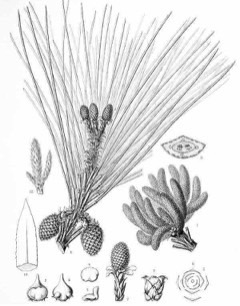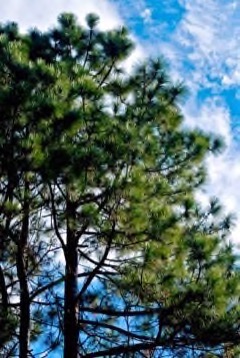 |
|
edibleplants.org |
 |
| wikimedia.org / TheSussman (Mike) |
Translate this page:
Summary
Physical Characteristics

 Pinus_elliottii is an evergreen Tree growing to 25 m (82ft) by 18 m (59ft) at a fast rate.
Pinus_elliottii is an evergreen Tree growing to 25 m (82ft) by 18 m (59ft) at a fast rate.
See above for USDA hardiness. It is hardy to UK zone 10. The flowers are pollinated by Wind.
Suitable for: light (sandy), medium (loamy) and heavy (clay) soils. Suitable pH: mildly acid and neutral soils and can grow in very acid soils.
It cannot grow in the shade. It prefers moist or wet soil and can tolerate drought.
UK Hardiness Map
US Hardiness Map
Synonyms
Pinus densa (Little & K.W.Dorman) de Laub. & Silba Pinus heterophylla (Elliott) Sudw. Pinus taeda heterophylla Elliott
Plant Habitats
Edible Uses
The seeds of all Pinus species are more or less edible, and some are of good size and make very tasty and nutritious foods, often eaten in quantitiy. Others can be less desireable, either having a strongly resinous flavour, being bitter or, more commonly, rather too small and fiddly to make it very worthwhle even trying to eat them, We have no specific information of the desireability of this species, though they are rather small (the size given includes the shell)[K]. The dark brown seeds are 6 - 7mm long[329].
References More on Edible Uses
Medicinal Uses
Plants For A Future can not take any responsibility for any adverse effects from the use of plants. Always seek advice from a professional before using a plant medicinally.
The plant contains turpentine, This has long been used internally for the treatment of catarrh, chronic bowel inflammation, colds, gonorrhea, leucorrhea, rheumatism, as well as various urinary complaints, rheumatism, and ulcers[269 ]
References More on Medicinal Uses
The Bookshop: Edible Plant Books
Our Latest books on Perennial Plants For Food Forests and Permaculture Gardens in paperback or digital formats.

Edible Tropical Plants
Food Forest Plants for Hotter Conditions: 250+ Plants For Tropical Food Forests & Permaculture Gardens.
More

Edible Temperate Plants
Plants for Your Food Forest: 500 Plants for Temperate Food Forests & Permaculture Gardens.
More

More Books
PFAF have eight books available in paperback and digital formats. Browse the shop for more information.
Shop Now
Other Uses
Oleoresin is tapped from the trees and distilled to obtain 12 - 13% turpentine and rosin[299 ]. Turpentine is used in the paint industry[299 ]. Rosin is used in the production of paper, soap and glue[299 ]. An essential oil is distilled from the needles[299 ]. The leaves yield around 0.3% of a balsam scented oil[269 ]. The main components are alpha-pinene (43.0%), beta-pinene (27.1%) and alpha-terpineol (9.6%)[299 ]. The heartwood is yellow to red-brown; it is not clearly demarcated from the 5 - 15cm wide band of yellowish white sapwood. The grain is straight, sometimes spiral; texture medium; growth rings are distinct. The wood is heavy, hard, tough, moderately durable to non-durable, being susceptible to attacks by Anobium borers, marine borers and termites. The resin content of the wood is high. The wood dries with little degrade, although some surface checking and splitting down the centre may occur. The wood is relatively difficult to work; resin may adhere to sawteeth and cutting edges, but the use of long-pitched sawteeth reduces this problem; it holds nails and screws well; glues, finishes and paints satisfactorily. The lightweight and soft wood from younger trees is mainly used for pulping, whereas the heavier and harder wood of older trees is used as timber. The straightness of the bole makes it particularly suitable for poles, piles and solid-wood products, but treatment with preservatives is often necessary. The wood is also suitable for construction, flooring, frames, joinery, interior trim, furniture, cabinet work, ship and boat building, vehicle bodies, toys, turnery, boxes, crates, veneer, plywood and particle board[299 , 672 ]. The wood is used for fuel[299 ]. Carbon Farming (Pinus elliottii and Pinus elliottii x caribea) - They can be used as an industrial crop - hydrocarbon and for agroforestry services as a windbreak.
Special Uses
References More on Other Uses
Cultivation details
Slash pine is a plant of the subtropics, but it can be cultivated in tropical regions at elevations from 500 - 2,500 metres. It grows best in areas where annual daytime temperatures are within the range 23 - 32°c, but can tolerate 8 - 36°c[418 ]. When dormant, the plant can survive temperatures down to about -5°c, but young growth can be severely damaged at 0°c[418 ]. It prefers a mean annual rainfall in the range 1,000 - 2,000mm, but tolerates 650 - 2,500mm[418 ]. Grows best in a sunny position[418 ]. Succeeds in a wide range of soils, growing best on mesic flatwood sites and on pond or stream margins where soil moisture is ample but not excessive, and drainage is poor[418 ]. Established stands grow well on flooded sites, but flooding restricts seedling establishment[418 ]. Established plants are drought tolerant[418 ]. Prefers a pH in the range 4.5 - 5.5, but tolerant of 4 - 6.5[418 ]. Tolerant of maritime exposure[418 ]. Widely planted for timber outside its native range, it has sometimes escaped and become naturalized. It can establish dense stands that shade out native plants and prevent their regeneration. Invaded grasslands are transformed over time into species poor shrublands and forests[305 ] A fast growing tree when young, it can live about 200 years[418 ]. Trees commence producing seed when around 7 - 8 years old[299 ]. Some seeds are produced each year, with good crops about every third year[379 ]. Individual cones take about 3 years to mature[299 ]. Annual oleoresin yields of 3 kilos per tree have been recorded from Zimbabwe[299 ]. Young trees are quite susceptible to fire injury until they are 3 - 4.5 metres tall, but then the bark becomes thick enough to insulate the cambium from high temperatures[299 ]. The tree has an extensive lateral root system and a moderate taproot[418 ]. Two geographic varieties exist for this species. The typical Pinus elliottii elliottii is found in the northern part of the range whilst Pinus elliottii densa is only found in southern Florida[418 ]. Both Pinus elliottii and Pinus elliottii x caribea are good Carbon Farming plants and have been partially domesticated to increase yields and other traits. They can be used as an industrial crop - hydrocarbon and for agroforestry services as a windbreak.
References Carbon Farming Information and Carbon Sequestration Information
Temperature Converter
Type a value in the Celsius field to convert the value to Fahrenheit:
Fahrenheit:
The PFAF Bookshop
Plants For A Future have a number of books available in paperback and digital form. Book titles include Edible Plants, Edible Perennials, Edible Trees,Edible Shrubs, Woodland Gardening, and Temperate Food Forest Plants. Our new book is Food Forest Plants For Hotter Conditions (Tropical and Sub-Tropical).
Shop Now
Plant Propagation
Seed - germination normally takes 15 - 20 days, and the germination rate of fresh seeds is usually 80 - 95%. The presence of mycorrhizae is highly beneficial for survival and early growth, so it is recommended to inoculate with spores or to add soil from near established trees. Seedlings can be planted out 4 - 8 months after germination, when they are about 30cm tall[299 ]. The seeds can be stored for years under dry, cold and airtight conditions[299 ].
Other Names
If available other names are mentioned here
English: swamp pine. Spanish: pino amarillo; pino macho. French: pin d'Elliott. Chinese: shi di song. Local Common Names: Brazil: pinheiro. Germany: Elliotts Kiefer. Italy: pino di Elliott. South Africa: basden. USA: Cuban pine; longleaf pitch pine; pitch pine; swamp pine; yellow slash pine.
Native Range
NORTHERN AMERICA: United States (Alabama (south), Florida, Georgia (south), Louisiana (southeast), Mississippi (south), South Carolina)
Weed Potential
Right plant wrong place. We are currently updating this section.
Please note that a plant may be invasive in one area but may not in your area so it's worth checking.
P. elliottii is a fast-growing tree that establishes dense stands that shade out native plants and prevent their regeneration. Invaded grasslands are transformed over time into species-poor shrublands and forests (Weber, 2003). P. elliottii is classed as a Category 2 invasive species in South Africa. Studies have been carried out into P. elliottii invasions into grassland savannahs, wetlands and coastal dune systems in Brazil. Zenni and Ziller (2011) found it to be one of the most pervasive and aggressive invaders of subtropical ombrophilous forest and savannah. In coastal dunes in Florianópolis in Santa Catarina state, P. elliottii seed rain was observed to be continuous throughout the year, generating about 2 million viable seeds/ha annually which compensated for the lack of a soil seedbank. Abreu and Durigan (2011) observed that invasion by P. elliottii was one of the most serious threats to the remaining cerrado vegetation in São Paulo state. In Argentina, P. elliottii has been observed invading overgrazed natural grasslands and other disturbed areas in Entre Rios, Corrientes and Misiones provinces, while in Queensland, Australia, the species has invaded heathland and open eucalypt forests (Richardson and Higgins, 1998).
Conservation Status
IUCN Red List of Threatened Plants Status : Status: Least Concern

Growth: S = slow M = medium F = fast. Soil: L = light (sandy) M = medium H = heavy (clay). pH: A = acid N = neutral B = basic (alkaline). Shade: F = full shade S = semi-shade N = no shade. Moisture: D = dry M = Moist We = wet Wa = water.
Now available:
Food Forest Plants for Mediterranean Conditions
350+ Perennial Plants For Mediterranean and Drier Food Forests and Permaculture Gardens.
[Paperback and eBook]
This is the third in Plants For A Future's series of plant guides for food forests tailored to
specific climate zones. Following volumes on temperate and tropical ecosystems, this book focuses
on species suited to Mediterranean conditions—regions with hot, dry summers and cool, wet winters,
often facing the added challenge of climate change.
Read More
Expert comment
Author
Engelm.
Botanical References
Links / References
For a list of references used on this page please go here
A special thanks to Ken Fern for some of the information used on this page.
Readers comment
| Add a comment |
|
If you have important information about this plant that may help other users please add a comment or link below. Only comments or links that are felt to be directly relevant to a plant will be included. If you think a comment/link or information contained on this page is inaccurate or misleading we would welcome your feedback at [email protected]. If you have questions about a plant please use the Forum on this website as we do not have the resources to answer questions ourselves.
* Please note: the comments by website users are not necessarily those held by PFAF and may give misleading or inaccurate information.
To leave a comment please Register or login here All comments need to be approved so will not appear immediately.
|
Subject : Pinus_elliottii
|
|
|
|